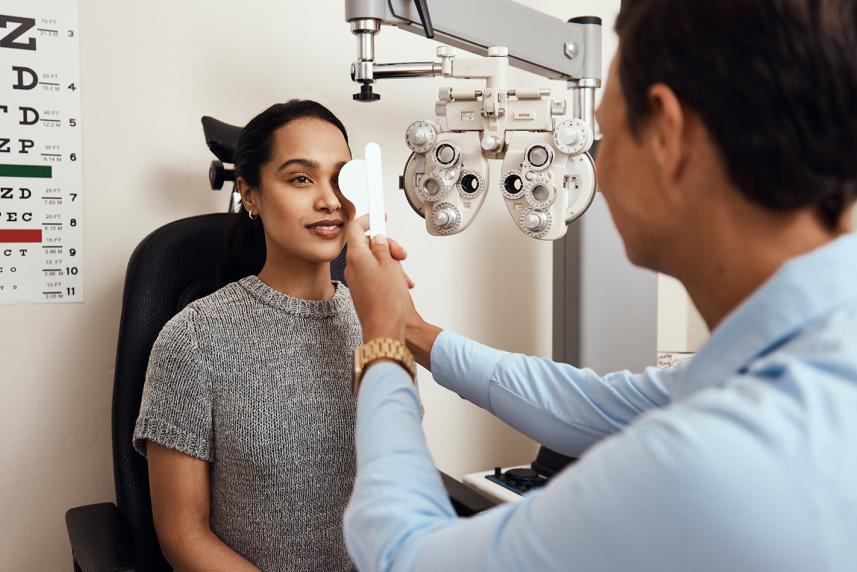
Stock up on your health care essentials at Optum Store. Use your HSA/FSA dollars to save even more.

Reduce strain and see better for longer with these healthy eye moves.
There are many things that change as you get older. And some of those changes will naturally affect your vision.
“The eye matures just like the rest of the body,” says Robert Ryan, O.D. He’s an optometrist with the Flaum Eye Institute at the University of Rochester Medical Center in western New York.
That means you may need reading glasses or a stronger prescription down the road. But you can you preserve more eye strength than you may realize. You may be surprised to learn there are things you can do to prevent sight-robbing eye diseases and improve your vision. (And no, none of them involves eating a pound of carrots every day.)
For starters, make sure you’re getting regular eye exams. According to the American Academy of Ophthalmology, even if you’re healthy and don’t have vision problems, you should book a complete eye exam at age 40. That’s when vision changes and eye diseases are more likely to start.
You’ll want to get checked more often if you wear glasses or have a condition, such as diabetes, that can put you at risk for eye disease. (If you’re taking medication to manage a chronic condition, we want to help you save. Show this free prescription discount card to your pharmacist for savings of up to 80%.)
The next thing you’ll want to do is start treating your eyes like the athletes they are. (Did you know that each eye has six muscles — and they’re the fastest ones in the body?) Here are five simple things you can do every day to keep your peepers in tip-top shape.
It’s safe to say that most of us don’t think about how often we blink. But maybe we should.
We tend to blink less when we look at screens or read digital text. A study in Optometry and Vision Science even found that people who read on a screen were more likely to have incomplete blinks, compared with those who perused on paper.
Turns out, that’s not great for eye health. Blinking keeps your eyes comfortably lubricated. And that helps you avoid symptoms of dry eye such as blurry vision, burning or stinging. (Read up on dry eye treatments here.)
How do you combat this? Well, quite simply, with the blink of an eye.
A study from the University of Auckland in New Zealand found that people who did blinking exercises several times a day for four weeks improved their symptoms of dry eye. Here’s how to do it:

Stock up on your health care essentials at Optum Store. Use your HSA/FSA dollars to save even more.
Do you spend a lot of your day staring at a computer screen, phone or e-reader? A lot of us do. Well, all that brightness and glare being emitted from the screen contributes to eyestrain and fatigue, says Ryan.
What’s more, your eye muscles have to work hard to continually focus on something at close range. “Like anything else, those muscles can cramp if they’re engaged too long. That can lead to blurred vision, headaches around the brow area, fatigue and dryness,” Ryan says.
To give your eyes some rest, try the 20-20-20 rule during the day: Take a 20-second break every 20 minutes to look at something 20 feet away. Doing so breaks up the demand on your eyes, allowing them to focus on a different distance so they can relax.
Think of this spa-like treatment as an exercise in self-care. A warm compress followed by a gentle eyelid massage can soothe tired eyes. Plus, it’s another way to help manage dry eye, says Ryan.
Setting a warm compress on your eyes “delivers heat that softens up the oils in eyelids, and massaging the eyelid can spread those oils across your eye. The function of the oils is to stop the evaporation of tear film,” explains Ryan. (When the glands housing the oils become inflamed, you’re more likely to develop dry eye.)
Eyes are sensitive. To make sure they stay safe, purchase a microwaveable eye mask, and follow the directions to warm it safely. And avoid vigorously rubbing your eyes, says Ryan, as that type of pressure can cause damage.
Many people turn to yoga to soothe achy muscles and relieve tightness. Could yoga-like exercises offer relief to tired and sore eyes, too?
A small study published in the International Journal of Yoga suggests it can. The researchers had half of the participants do eye yoga five days a week, while the other half didn’t. The exercises included blinking, palming (when you place your hands over closed eyes) and moving the eyes in various directions (looking up and down, side to side, in a circle, and near and far).
After six weeks, those who did the eye exercises reported less fatigue and eyestrain than those who didn’t. While more research is needed, the authors suggest adding eye exercises to your regular yoga (or stretching) routine.
Whether you like to walk, bike ride or move alongside a fitness app in your living room, regular physical activity is a boon for your vision.
“The eye is full of blood vessels. There is a lot of blood circulation that nourishes the eye,” says Ryan. And when health conditions such as heart disease, high blood pressure or diabetes hurt blood vessels, it could mean your eyes aren’t getting the nutrients they need.
Put in simple terms, what’s healthy for your heart is healthy for your eyes, too. Regular physical activity helps keep blood vessels flexible, ensuring good blood flow.
Your goal: Aim to be active 30 minutes each day. Need some inspiration? Try our two-week fitness challenge.
Additional sources
Eye exam basics: American Academy of Ophthalmology
Study on how screens impact our blinking: Optometry and Vision Science (2014). “Blink patterns: reading from a computer screen versus hard copy”
Study on blinking exercise and dry eye symptoms: Contact Lens and Anterior Eye (2021). “Therapeutic benefits of blinking exercises in dry eye disease”
Study on eye yoga and eyestrain: International Journal of Yoga (2020). “Effect of yoga ocular exercises on eye fatigue”
© 2024 Optum, Inc. All rights reserved. Do not reproduce, transmit or modify any information or content on this website in any form or by any means without the express written permission of Optum.
The information featured in this site is general in nature. The site provides health information designed to complement your personal health management. It does not provide medical advice or health services and is not meant to replace professional advice or imply coverage of specific clinical services or products. The inclusion of links to other websites does not imply any endorsement of the material on such websites.
Stock photo. Posed by model.